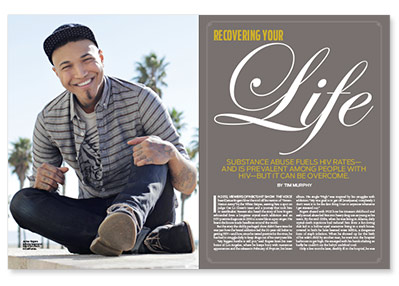
In 2012, viewers of NBC’s hit show The Voice heard Jamar Rogers blow the roof off his version of “Seven-Nation Army” by the White Stripes, earning him a spot on judge Cee Lo Green’s team and a journey that took him to semifinalist. Viewers also heard the story of how Rogers rebounded from a longtime crystal-meth addiction and an HIV-positive diagnosis in 2006 to a new life as a pro singer. His brave disclosure made headlines around the world.
But the story the slickly packaged show didn’t have time for was just how the brutal addiction led the 31-year-old belter to getting HIV—and how, since he tested positive for the virus, he has had to struggle daily to keep drugs out of his starry new life.
“My biggest hurdle is still pot,” said Rogers from his new home of Los Angeles, where he keeps busy with numerous appearances and the release in February of Projector, his latest album. His single “High” was inspired by his struggles with addiction. “My one goal is to get off [marijuana] completely. I don’t want it to be the first thing I run to anymore whenever I get stressed out.”
Rogers shared with POZ how his itinerant childhood and early sexual abuse led him into heavy drug use as young as his teens. By the mid-2000s, when he was living in Atlanta, daily crystal-meth injections had reduced him from a fun-loving club kid to a hollow-eyed scarecrow living in a crack house, covered in boils he later learned were MRSA, a dangerous form of staph infection. When he showed up for the birth of his wife’s child by another man, he went into the hospital bathroom to get high. He emerged with his hands shaking so badly he couldn’t cut the baby’s umbilical cord.
Only a few months later, deathly ill in the hospital, he was finally diagnosed with the virus. He had a paltry five CD4 cells. “I was freezing cold, I had thrush in my mouth—I had some 1980s shit going on!” he laughs today. Rogers, who identifies as bisexual, says he doesn’t know if he got HIV from having unsafe sex or sharing needles, but the diagnosis was the kick in the pants he needed not only to get on HIV meds and regain his health, but also to finally get clean. He and his wife moved to Milwaukee, where he started singing for a church that knew and accepted his whole life story.
A few years later, single and aiming for fame in New York City, he plunged into a new church, volunteered for people with HIV/AIDS and attended 12-step meetings with other recovering alcoholics and addicts. “I found love and community in church, but in 12-step meetings I heard other people’s stories like my own—and I got to do service in the group,” he says. 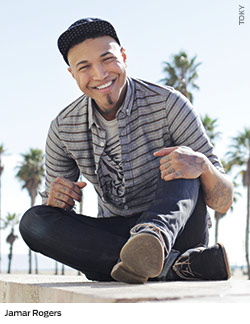 Despite a life filled with spirituality and sober support, Rogers had a small meth relapse while still in New York City, and there’s his continuing struggle with marijuana. “I have my daily communication with God,” he says. “I spent 30 minutes talking to Him before this interview asking what I should say.”
Despite a life filled with spirituality and sober support, Rogers had a small meth relapse while still in New York City, and there’s his continuing struggle with marijuana. “I have my daily communication with God,” he says. “I spent 30 minutes talking to Him before this interview asking what I should say.”
Rogers is on a journey—to live fully and healthy with HIV after addiction. “When I found out I was HIV positive,” he says, “a small whisper inside me said, ‘You’re going to be OK.’ And I vowed I’d do whatever I had to do to survive this.”
Rogers’s journey is one that many HIV-positive folks find themselves on. According to a 2010 Substance Abuse and Mental Health Services Administration (SAMHSA) report, nearly 25 percent of Americans with HIV/AIDS were in need of treatment for alcohol or illicit drug use. Meanwhile, according to a 2011 SAMHSA report, less than 10 percent of the population at large had substance dependence over the past decade.
Why are rates so much higher among people with HIV? “Substance use is a coping reaction for many people with HIV,” says Perry Halkitis, PhD, a New York University professor who has spent years studying drug use in HIV-positive people and has written a forthcoming book, The AIDS Generation, on the topic. “Living with HIV isn’t just a medical condition. It’s an emotional and social reality, and substance use ameliorates the negative feelings around it. We can say there’s no stigma around having HIV, but there is. And people who have been HIV positive for decades often have a lifetime of trauma to deal with. Using is an easy fix to confront those negative states.”
Just ask “K.T.,” a 53-year-old African-American Atlanta woman who was shooting drugs when she learned she had HIV in 1987, back when the diagnosis was widely seen as a death sentence. “If I hadn’t been doing drugs when I found out, I’d have lost my mind,” she says. “At the time, it helped me numb the news.” She’s been clean two years now.
But an anesthetic is not a real fix for coping with HIV—what’s more, it can make HIV worse. Numerous studies have found that excessive drinking and drug use are harmful to the physical and cognitive health of people with HIV, not to mention that they are frequent deterrents to taking prescribed medications, HIV-related and otherwise.
In recent years, experts and the media have caught on to the high rates of crystal meth use among HIV-positive gay and/or bisexual men such as Rogers. Last December, many viewers of the Oscar-nominated documentary How to Survive a Plague, about the members of ACT UP and the Treatment Action Group (TAG) who pushed for effective HIV treatment in the late 1980s and early ’90s, were dismayed to learn that Spencer Cox, one of the HIV-positive activists featured in the film, had died of AIDS-related complications after not taking his HIV medications. For years, Cox had struggled with a crystal meth addiction. Mark Harrington, a colleague of Cox and the executive director of TAG, told The New York Times after his death, “He saved the lives of millions, but he couldn’t save his own.”
Cox’s death especially moved Mark S. King of Atlanta, who writes My Fabulous Disease, a sassy blog about living with HIV. King, 52, started writing soon after he tested positive in 1985. He made it to the protease age by throwing himself into spirituality and AIDS services work, only to plunge into the meth- and muscle-driven gay circuit-party world in the late ’90s.
“It felt like a celebration and freedom and escape after all I had been through, watching friends die,” he says. “But the drugs became more and more important until I wouldn’t even go to parties anymore. I became an isolated, pathetic daily injection drug user.” Since then, his life has been an up-and-down struggle to break free of the grip of crystal. At press time, he had been six months clean, thanks, he said, to 12-step meetings and the therapeutic benefits of blogging.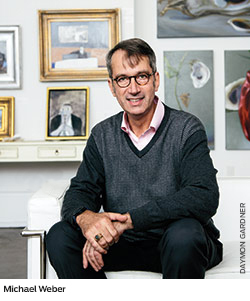 In New Orleans, Michael Weber, 57, has a similar story. He’s the first to admit he has always had addictive tendencies. “My first drink when I was 16 turned into a blackout,” he jokes. But when his longtime lover, Dennis, died of AIDS in 1990, Weber plunged into a 19-year abyss of addiction—first heavy drinking, coke and pot, then, starting in 2005, meth. “I never dealt with his death,” he says. “I did nothing right in my grieving, never saw a therapist.”
In New Orleans, Michael Weber, 57, has a similar story. He’s the first to admit he has always had addictive tendencies. “My first drink when I was 16 turned into a blackout,” he jokes. But when his longtime lover, Dennis, died of AIDS in 1990, Weber plunged into a 19-year abyss of addiction—first heavy drinking, coke and pot, then, starting in 2005, meth. “I never dealt with his death,” he says. “I did nothing right in my grieving, never saw a therapist.”
He also didn’t bother getting an HIV test of his own all those years, even though he was virtually certain he was positive, because he and Dennis had always had unprotected sex. Weber learned he was positive in 2007, when, in a strange irony, his own drug dealer dragged him to an outpatient rehab program at the city’s N.O. AIDS Task Force. That program, and the 12-step meetings that followed, was the start of his road back to life. Today, he is four years clean and sober; he’s also the events coordinator for N.O. AIDS. “I wish Dennis could see the person I am now,” he says.
But of course, gay men like King and Weber are not the only HIV-positive folks who struggle with addiction. “One of the hardest HIV populations to keep in drug treatment is women,” says Moneta Sinclair, who heads addiction services at Atlanta’s HIV agency Positive Impact. “They tend to be caretakers for everyone but themselves. And often there’s low self-esteem involved, a connection to some other person supporting their drug habit.”
Low self-esteem, in fact, was one of the factors that led to cocaine and heroin addiction for Lynn Morrow, 58, of Charlotte, North Carolina. She used for years until she ended up at a state addiction treatment center in 1999, where she learned she was HIV positive. But even after she left the center, she kept on using, until seven years ago.
“Finally I accepted that I was an addict and asked for help,” Morrow says. Two years ago, she went back to a treatment center, this time for addiction to prescription painkillers. Today, she stays clean with a combination of 12-step meetings, Bible study, taking care of her grandson, Bryant, and fun stuff like shooting pool and watching The Real Housewives of Atlanta. In meetings, she says, “I hear what other people have to go through—and I think, ‘If they can go through that not having to use drugs, I can too.’”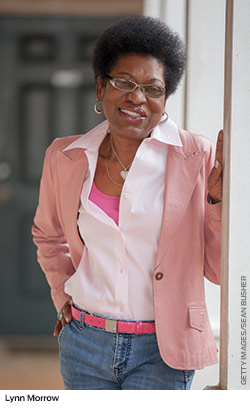 Identifying addiction as a major problem for many people with HIV is one thing. It’s another to address it. Some positive folks, like Rogers, have found that they can continue to use some substances, like pot or an occasional beer or two, without the devastating health and social consequences of other substances, such as crystal meth. Others have found a path to giving up all substances through the rooms of Alcoholics Anonymous (AA), Narcotics Anonymous (NA), Crystal Meth Anonymous and other 12-step programs, which abound in large and midsize cities and hold at least a skeletal presence in small ones and suburban areas. In those meetings, says Morrow, “You got people who share their stories, and you all got one thing in common—you’re addicts.” That common bond is the glue that keeps many coming back to 12-step meetings. “When I was drinking and drugging, there was nobody in my life who cared about me,” Weber says. “It’s amazing to have a community of sober friends now.”
Identifying addiction as a major problem for many people with HIV is one thing. It’s another to address it. Some positive folks, like Rogers, have found that they can continue to use some substances, like pot or an occasional beer or two, without the devastating health and social consequences of other substances, such as crystal meth. Others have found a path to giving up all substances through the rooms of Alcoholics Anonymous (AA), Narcotics Anonymous (NA), Crystal Meth Anonymous and other 12-step programs, which abound in large and midsize cities and hold at least a skeletal presence in small ones and suburban areas. In those meetings, says Morrow, “You got people who share their stories, and you all got one thing in common—you’re addicts.” That common bond is the glue that keeps many coming back to 12-step meetings. “When I was drinking and drugging, there was nobody in my life who cared about me,” Weber says. “It’s amazing to have a community of sober friends now.”
But the 12-step model is not for everyone. It’s the gold standard of long-term recovery, says Cathy Reback, PhD, a senior research scientist at Baltimore’s Friends Research Institute, where she studies addiction and treatment in gay men and transgender women at high risk for HIV, “but it doesn’t work for everybody, and people who don’t embrace it shouldn’t be denied a treatment opportunity.” In many 12-step programs, there is a strong belief that one must “surrender” one’s will to God, or a “Higher Power,” in order to get clean or sober. However, many people who go to 12-step meetings are turned off by the religious tone of some meetings and the fact that some 12-step programs use literature that heavily contains references to God.
That’s the case with “Benn,” 56, a gay male government worker in Charlotte, North Carolina, diagnosed with HIV in 1996 and clean from crystal meth and all other substances for five years now. Benn says that the 12-step model helped him get clean. “If it hadn’t been for Crystal Meth Anonymous’s rigid and unwavering rules, I wouldn’t have made it,” he says. “It had to be all or nothing, by the book, doing my steps, working with a sponsor.” But five years later, says Benn, he’s come to chafe at the program’s religiosity. “I was raised Southern Baptist, but there’s more prayer in a lot of the meetings than I’m comfortable with. Some of them end with the Lord’s Prayer.”
He continues to go to meetings for now because he acknowledges that they work. He’s also looking into starting a 12-step meeting for agnostics and/or atheists. Such meetings already exist in many cities. And recently he cofounded an informal addiction and recovery support group at his HIV care provider, Charlotte’s Rosedale Infectious Diseases. His cofounder, Wesley Thompson, a physician’s assistant there, says the group is small but growing. “There are no religious overtones,” says Thompson, while acknowledging that 12-step meetings are highly effective for many. “It’s a place for open discussions. People will say, ‘I have HIV and I couldn’t perform sexually because I thought no one would want to touch me, but when I did crystal, I wasn’t afraid to be touched.’” Thompson believes that drug users must get in touch with their root reasons for using before they can work toward stopping.
As for Weber, he says that in order to make AA work for him he had to embrace spirituality beyond the idea of the standard Charlton Heston white male God. “Once in a meeting, I heard somebody say, ‘I don’t believe in that guy on the cross, but I know there’s something out there greater than me.’ When I realized I didn’t have to put a face on God or call it Jesus, I started to feel the presence of something.”
Most folks agree that, 12-step or otherwise, the key to recovery is to become part of a supportive community larger than oneself. That’s worked wonders for K.T. in Atlanta, who finds community in NA meetings, at her church and at SisterLove, a 21-year-old Atlanta agency that serves women living with, or at risk for, HIV/AIDS. “My positive sisters always let me know when they have something going on,” she says. “We make jewelry together, listen to music, have a bite or two, go on a little trip. I’m a firm believer in keeping hope alive.”
But in the same breath, K.T. mentions something that many HIV-positive people in recovery struggle with—how to let go and have fun, not to mention find intimacy, sex and love without the crutch of substances. “I like dancing, but I don’t have anyone to take me,” she says. She adds that she might finally be ready to look for companionship on sites like POZ Personals or even to simply go out and hit the dance floor with her HIV-positive girl-crew.
Weber struggles with the same issues. “I haven’t dated in four years,” he says. “I’d like to, [but] New Orleans is a huge party town. I have to be very careful who I let into my life.” For now, he socializes through his work and his 12-step buddies, and he’s looking to take art classes. But down the line, he says, “I might have to move to a bigger city with a deeper gene pool. I’m free to explore and take risks now that I’m sober.”
The bottom line? “Find whatever resources are available in your community,” Reback says. “If you’re in a rural environment whose only 12-step meetings have religious overtones, you just might have to put up with that to hear the message underneath.” Reach out to friends, family, doctors, therapists, faith groups, online support networks, your local HIV/AIDS agency—anywhere you feel safe and secure admitting you have a problem.
After all, comebacks start by asking for help. Jamar Rogers knows that. For him, a journey that began in a hospital room led to his deciding to go public with his struggles as a means of giving hope to others. “Between taping my disclosure and it airing publicly, I was a wreck,” he says. “I fell into a depression. Then the day after the show aired, I was running to the bank in New York and a Puerto Rican guy recognized me and said, ‘Hey papi, I’m an ex-heroin addict, and I’ve been living with HIV for 25 years.’ I thought to myself, ‘OK, I did the right thing.’”
Breaking the Cycle
Steps you can take toward cracking addiction’s grip.
TEST YOURSELF
See if you can control your use by having only one drink a night—or smoking pot just once a week. If you can’t, or if it’s torture to do so, you might need help. Quizzes at alcoholscreening.org and addictionnomore.com can also help you answer that question.
TRY HARM REDUCTION
Not yet willing or able to stop drinking or using completely? You can still try to minimize its effect on your health and HIV management. Start by being honest with your doctor and/or therapist about your use. And learn more at harmreduction.org.
REACH OUT FOR HELP
For a list of HIV/AIDS centers near you, type your ZIP code into directory.poz.com. One may have counselors or groups for substance problems. There’s always good old-fashioned Alcoholics Anonymous (aa.org), Narcotics Anonymous (na.org) and 12-step groups for addictions ranging from meth to pot to compulsive sex. Turned off by 12-step? Try the leading alternative: smartrecovery.org.
GO AWAY
Maybe you need to go away to rehab to jump-start your recovery. The fun, newsy addiction website thefix.com includes rehab reviews and has a free rehab helpline at 1.888.GET.FIXED.
FIND YOUR BLISS
What’s the point of getting clean or sober if you’re going to mope? Sure, life after addiction has its ups and downs—but it’s a great chance to learn what really brings you joy. As if channeling Oprah Winfrey, Jamar Rogers says: “Let’s live our best lives!"


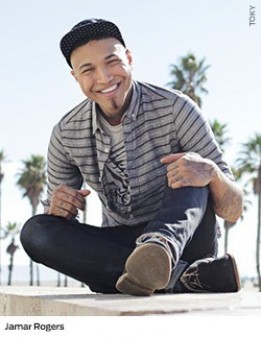




4 Comments
4 Comments